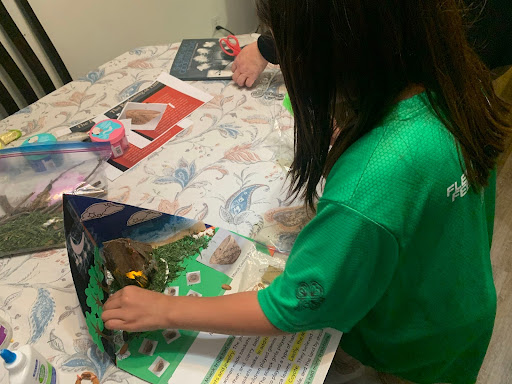Overview
Native Homes: Sustainability and the Environment (3D Diorama)

Author: Elizabeth Lewis, Ella Williams (Miwok, Hupa), Winter McCovey (Hupa, Yurok, Karuk)
Lesson partner: Rebecca Lowry, Humboldt County Office of Education
Grades: 4-5
Suggested Amount of Time: 1-2 weeks of 45-60 minute sessions (8 lessons)
Curriculum Themes
- History
- Cultural Strengths
- Relationship to Place
- Cross Curricular Integration
Learning Goals
Students will:
- Learn about the homes/ structures, trade and other traditional cultural items used by Hoopa, Miwok and other indigenous people through online research.
- Make a 3D model representing what they have learned.
- Give a presentation sharing what they know and are still learning about specific indigenous groups (as assigned by the teacher).
Lesson Overview
This ELA, Social Science and Environmental History lesson introduces students to architectural practices and knowledge of structure and design through dioramas. Native Youth will guide you by modeling the project. Your students will learn about Hoopa and Miwok structures and culture and then will research and complete their own project. This unit may take a few weeks, but it is worth it. It is a lot of fun and will provide a deep understanding of Native culture for your students if done correctly.
The teacher must:
- Understand we are on Native land
- Actively engage critical thinking skills, note taking skills, and discussion skills.
- Understand that quality research takes time and tribal voices may be difficult to find, but are important to include in your learning.
- Look for individual growth and expectations based on student needs
Teacher Background
Before Colonization, Native American peoples of California lived in complex societies that included a myriad of architectural structures. These were built based on their cultural needs and their unique environments.
Many people refer to Native Americans as being “hunter gatherers,” though these terms do not illustrate the complexity of the diverse Native cultures and knowledge present in California Native cultures. The varied climates throughout California (coasts with chilling fog, dry and hot valleys, foothill regions with heavy rains, snowy mountain ranges and forests, etc) led different groups of people living in each area to build unique structures and homes from local resources.
Indigenous homes across California were sustainable, environmentally friendly and affordable. Teaching students about these unique structures in this unit will help them to develop research skills, give them real life practice modeling and engineering, and will develop their speaking and listening skills. They will also have exposure to indigenous ideas related to housing- valuable information as our society works to combat the housing crisis and homelessness as well as structural challenges related to climate change.
In this lesson, students will build their own dioramas based on what they have learned. This is an optional lesson, and some people may decide that they do not have the time, materials or energy for it. However, I really encourage you to challenge yourself and remember that the indigenous people have had to endure much more difficult challenges and yet have survived and thrived.
The diorama can be a wonderful home connection. If you choose to have students complete it at home, make sure to have frequent check-ins to see if there is anyone who is unable to complete their project at home. Providing alternatives, such as an online project or a drawing/painting instead can sometimes help support these students. You may want to have a study hall time a day before these are due and provide materials for students who may not have resources at home on this day. It can also be a fun activity to go on a class walk to gather materials for the dioramas on the day you begin this lesson. If done at home, make sure to communicate your expectations clearly to families and let them know you can support students at school if needed.
Essential Question:
How have indigenous people worked together with nature to gather and/or design structures, tools, clothing and food that has enabled them to survive for time immemorial?
Additional considerations:
In this unit, students will research an indigenous group of people and take notes based on their findings. It is imperative that students use good sources to include the most accurate representations as possible. Please use the checklist with students to review what makes a good source. First hand knowledge through a youtube video may be better than an official university article. If you struggle to find good sources for a tribe, please use this as a discussion piece and encourage students to think critically about why the sources available are what they are.
4th graders should be encouraged to research a CA tribal group. 5th graders should be encouraged to research an indigenous people of the Americas. Because we are beginning with time immemorial, indigenous peoples that live beyond current National borders can also be considered. I encourage you to consider including the indigenous peoples of the Pacific Islands and Caribbean Islands for a deep and rich understanding of indigenous peoples/ trade/ and cultures that will also connect to your studies of exploration and colonization later in the year.
If a student identifies as Native American or indigenous and would like to research their own people, I would recommend allowing it. Doing so will increase motivation and understanding across cultures. Students will naturally compare and contrast the projects and families will enjoy being involved if applicable.

